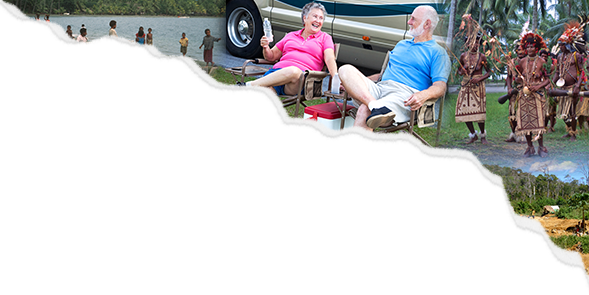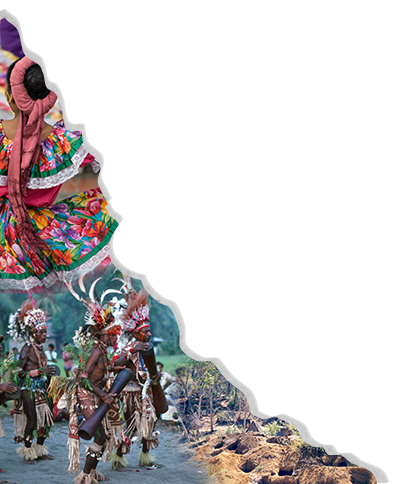This is the second of a two-part blog post by Marie-Eve Carrier Moisan discussing the challenges and potentials of transforming ethnographic research into graphic novel form.
In my first blog, I discussed the process of fictionalizing ethnographic graphic research, and the challenges this presents for me as I adapt my ethnography into graphic form. In this post I focus on the the juxtaposition of image and text, a unique feature of comics and graphic novels.
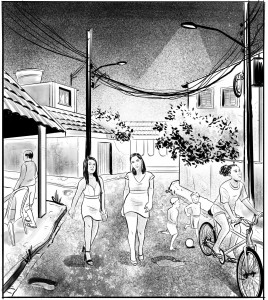 In the process of making Gringo Love, I became increasingly aware of the way the medium presents me with the challenge of thinking in pictures – or perhaps more accurately, of thinking in image + text. In an interview on this blog, scholar-cartoonist Nick Sousanis and author of Unflattening, the first PhD dissertation in comic form, aptly suggests that in comics and graphic novels, the unique combination of word-image and their interactions afford us the possibility to engage at once with “two reading modes”, or “awareness”, making possible constant reinterpretations. As he puts it: “We can focus, follow a single thought, but still have that overall awareness of our surroundings, be present to the tangential.” This creates possibilities but also challenges for the novice, discursively-oriented thinker like me, who has a hard time letting go of the primacy of words over images in meaning-making. In the first iteration of the graphic story, my discursive inclination overtook the story. I could not let go of the use of verbatim quotes even if at times they felt lengthy and convoluted, I was too committed to the ethnography! In some places, the text also burdened the images, as I tried to cram in many different contextual or historical aspects. I found myself perhaps framing too much, discursively, the meaning of the images for readers, instead of letting the interaction of images and texts produce something else. With the guidance of the series editor Anne Brackenbury and cartoonist Marc Parenteau, and in collaboration with the help of my collaborator, William Flynn, I have reworked the dialogues. In many instances, I cut down the length of quotes or changed words that felt clumsy. Sometimes, I deleted entire speech balloons as they were redundant with the visuals. I also, as discussed above, have moved more on more towards fictionalization, which has helped letting go of the verbatim quotes and obsession with reproducing exactly how things happened.
In the process of making Gringo Love, I became increasingly aware of the way the medium presents me with the challenge of thinking in pictures – or perhaps more accurately, of thinking in image + text. In an interview on this blog, scholar-cartoonist Nick Sousanis and author of Unflattening, the first PhD dissertation in comic form, aptly suggests that in comics and graphic novels, the unique combination of word-image and their interactions afford us the possibility to engage at once with “two reading modes”, or “awareness”, making possible constant reinterpretations. As he puts it: “We can focus, follow a single thought, but still have that overall awareness of our surroundings, be present to the tangential.” This creates possibilities but also challenges for the novice, discursively-oriented thinker like me, who has a hard time letting go of the primacy of words over images in meaning-making. In the first iteration of the graphic story, my discursive inclination overtook the story. I could not let go of the use of verbatim quotes even if at times they felt lengthy and convoluted, I was too committed to the ethnography! In some places, the text also burdened the images, as I tried to cram in many different contextual or historical aspects. I found myself perhaps framing too much, discursively, the meaning of the images for readers, instead of letting the interaction of images and texts produce something else. With the guidance of the series editor Anne Brackenbury and cartoonist Marc Parenteau, and in collaboration with the help of my collaborator, William Flynn, I have reworked the dialogues. In many instances, I cut down the length of quotes or changed words that felt clumsy. Sometimes, I deleted entire speech balloons as they were redundant with the visuals. I also, as discussed above, have moved more on more towards fictionalization, which has helped letting go of the verbatim quotes and obsession with reproducing exactly how things happened.
I am thus becoming increasingly aware, as I am making Gringo Love, that the combination of image + text requires telling anthropology otherwise. And by otherwise, I do not mean “simpler”, quite the contrary!
When my collaborator and husband Billy (William Flynn) and I first began working on Gringo Love, our impulse was to think of this medium mainly as opening up possibilities to disseminate my research work to a broader, non-specialist audience (see On the Educational Potentials of Graphic Novels). Initially, I imagined the project as a way to engage various publics beyond academia, as it felt like I was taking part in a close conversation among those of us doing ethnographic research on sex tourism, and which tended to focus on very specific and narrow debates and arguments. The idea came from my husband, as I struggled to think about ways to make my work on sex tourism more accessible. It seems like drawings partly solve the challenges posed by other forms of visual representation like documentary films or photographs, given the potential harm of outing oneself as someone engaging in sex tourism (see for instance Stout, on the unforeseen harms to video participants in her research with Cuban sex workers). I also imagined this medium as providing unique possibilities to engage readers on a difficult and contentious subject by allowing them to identify with key characters and their everyday experiences in sex tourism, and by making it more accessible to them.
In some ways, I was hierarchizing or positioning graphic novels/comics as less complex than literary texts. As I work my way through this project, I have come to think about it differently: while I still think that graphic novels constitute a form of critical pedagogy with transformative potential, I also recognize that the medium allows us to know otherwise – that is, in distinct, and not simpler, ways. Alexis Shotwell, in Knowing Otherwise: Race, Gender, and Implicit Understanding, discusses the significance of implicit, tacit knowledge allowing us to know the world differently – through our body, senses, emotions, and through inarticulate common sense– and which she sees as crucial for political transformations. The idea of knowing otherwise also hints at attempts to decenter Western notions of knowing, or what Sousanis refers to as the primacy of words over images in understanding. Unflattening makes a case for recognizing both the medium as a legitimate knowledge and the visual mode as complex as the literary form. In any case, there is no doubt that comics and graphic novels have the potential to address complex social issues seriously – the examples are many, including Pulitzer prize-winning Maus, by Art Spiegelman, classics like Persepolis by Marjane Satrapi and Fun Home by Allison Bechdel, or the lesser-known but frank and revealing Melody by Sylvie Rancourt.
The visuals can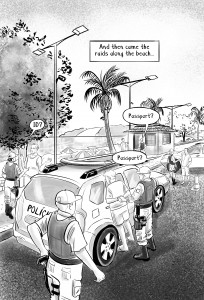 achieve that which text alone cannot accomplish. Images can give us a sense of a place in one single gaze. Compared to long, exhaustively written ethnographic descriptions of particular places, comics are highly effective in giving a sense of place, something I find compelling as I work more with the medium.
achieve that which text alone cannot accomplish. Images can give us a sense of a place in one single gaze. Compared to long, exhaustively written ethnographic descriptions of particular places, comics are highly effective in giving a sense of place, something I find compelling as I work more with the medium.
In the process of making Gringo Love, I am constantly humbled by my limits and made aware of the intricacies of trying to find the fine balance of image + text so that neither image or text reduces or overpowers the other. This requires a constant awareness of their interactions, and what happens when they come together to co-constitute meanings. In his landmark Understanding Comics, cartoonist and comics theorists Scott McCloud discusses this tension between “show” and “tell”, and uses the metaphor of a dance in which partners take turns. He proposes ways to exploit them both, also recognizing that “the mixing of words and pictures is more alchemy than science” (161).
This intricate mixing is further complicated by the process of co-creation, which involves my two collaborators Billy and Débora, without whom I could not have done this project! In Gringo Love, the story is almost entirely based on conversations, either at the beach or in bars and nightclubs, which makes it difficult to keep the interest of the readers and move the storyline. In the storyboarding of the graphic novel, Billy brings many clever ideas of how to break some of the more monotonous scenes. It usually works, but it may be helpful to provide an example of what does not work as well. Billy thought of illustrating a metaphor in a panel where a tourist reflects on the authenticity of his experience in sex tourism and suggests that it is like a “stage theatre”. Billy proposed to use the image of a stage theatre with curtains and a play slightly visible in the background. It seemed like a brilliant way to break the repetitious bar scene, but it did not fare well once it was drawn, as both the image and the text repeated one another. In another instance, Billy’s metaphor worked very well to break the dullness of a beach sequence. Playing on the idea of gambling in card games, he suggested drawing panels as individual cards. Each card would depict a scenario characterizing an interaction between a foreign man and a Brazilian woman, to indicate what one woman referred to as situations that were a bit of a gamble. In this case, the image and the text are more suggestive, and the metaphor adds an emphasis to what the woman is saying.
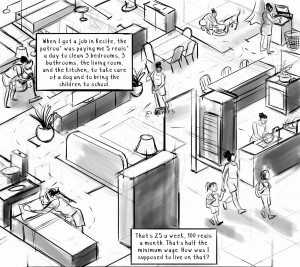 It is Débora, however, who gives life to the graphic novel, finds creative ways to vary the scene and rhythm, and reminds us of the fine balance of text and image. Instead of simply drawing what we ask her, she modifies the size, shape, number of panels; she makes suggestions to break one page into two; she adds many visual elements to a scene; and she suggests alternatives. While I feared that as a middle-class Brazilian woman from the Northeast, she may have preconceptions about the women in my story, Débora represents them in a way that feels sincere, fair, respectful and that work against typical representations of these women as victims.
It is Débora, however, who gives life to the graphic novel, finds creative ways to vary the scene and rhythm, and reminds us of the fine balance of text and image. Instead of simply drawing what we ask her, she modifies the size, shape, number of panels; she makes suggestions to break one page into two; she adds many visual elements to a scene; and she suggests alternatives. While I feared that as a middle-class Brazilian woman from the Northeast, she may have preconceptions about the women in my story, Débora represents them in a way that feels sincere, fair, respectful and that work against typical representations of these women as victims.
One panel I feel illustrates well how the three of us create together is still in a draft version. It shows many representations of the same woman in the house of well off Brazilians, capturing the intensity and the demands of her work in one single gaze. While the scene drew on my ethnographic research, Billy had the vision for it, and Débora realized it, adding the birds-eye view and many visual details we had not thought about, like the plant, lamp, basket, and school bags for the kids.
As I am nearing completion of this project, I would suggest to anyone who wants to pursue ethnography in graphic form to immerse themselves into the medium, like a good anthropologist – whether by reading many graphic novels and comics, attending comic arts festival, reading “how-to” guide like Scott McCloud’s Making Comics, meeting graphic artists, or even enrolling in a course on comics, like anthropologist Stacey Leigh Pigg.
